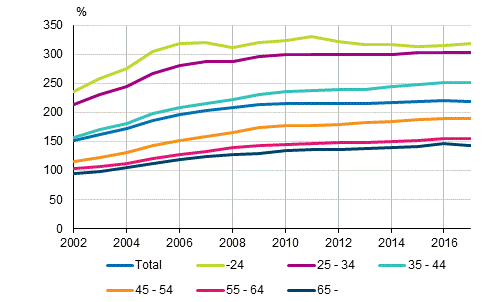Published: 25 January 2019
Household-dwelling units with housing loans are EUR 98,740 in debt
In 2017, household-dwelling units with housing loans had, on average, 219 per cent of their disposable income in debt. Household-dwelling units in the group under the age of 35 had the largest debts in proportion to income. Their debt was, on average, a little over three times their annual income. The average size of a housing loan per household-dwelling unit with a housing loan was EUR 98,740, which was 0.8 per cent more than in the previous year.
Rates of indebtedness of household-dwelling units with housing loans by the age of the reference person in 2002 to 2017, %

In 2017, the total number of indebted household-dwelling units was EUR 1.4 million, i.e. slightly over one-half of all household-dwelling units. Their debt amounted to EUR 120.9 billion in total, which was 1.9 per cent more than the previous year. Since 2002, the number of indebted household-dwelling units has gone up by ten per cent and the debts by 117 per cent in real terms.
Debts grew by 1.9 per cent from the previous year. Household-dwelling units’ disposable monetary income grew slightly more than their debts, by 2.4 per cent, so the rate of indebtedness of household-dwelling units fell slightly. In 2017, the rate of indebtedness of all household-dwelling units was 112 per cent, while it was 113 per cent the year before.
EUR 86.8 billion, or 72 per cent, of debts were housing loans. One-third of all household-dwelling units, or 878,800, had housing loans. The housing loans grew by 0.7 per cent year-on-year. Altogether 80,260 household-dwelling units had debts taken out for business purposes. They amounted to EUR 7.4 billion, which was 2.5 per cent more than in the previous year. Around one million household-dwelling units had other debts amounting to EUR 26.7 billion, 5.7 per cent more than in the previous year. Other debts include loans for consumption and larger purchases, such as a car or free-time residence, as well as student loans.
In almost one-fifth of indebted household-dwelling units, that is, 269,750 household-dwelling units, the debts were three times as high as their disposable annual income. They held one-half of household-dwelling units' all debts. In 2002, altogether 97,380 household-dwelling units were this much in debt, that is, eight per cent of indebted household-dwelling units. Household-dwelling units that had debts at least five times as high as their annual income numbered 66,740 in 2017.
Two-supporter families with children, where the reference person was aged under 45, often had much debt compared to their disposable income. In childless household-dwelling units with one or two adults high debts were more common in household-dwelling units of those aged 25 to 34. Single-supporters with housing loans often had much debt compared to the income.
Household-dwelling units in Åland, Greater Helsinki and elsewhere in Helsinki-Uusimaa had the highest housing loans. Forty-one per cent of the household-dwelling units with housing loans in Åland, 37 per cent in Greater Helsinki and 33 per cent elsewhere in Helsinki-Uusimaa had debts that were at least triple their annual income. High housing loans are found least in Northern and Eastern Finland, where one quarter of the household-dwelling units with housing loans had that much debt.
Of the household-dwelling units belonging to the lowest income quintile, 43 per cent had debts that were at least triple compared with their annual income, while 24 per cent of the household-dwelling units in the highest income quintile had as much debt in relative terms. On average, household-dwelling units belonging to the lowest income quintile had EUR 64,490 in housing loans and those in the highest income quintile EUR 127,920.
Household-dwelling units paid EUR 1.6 billion in interests in 2017. Household-dwelling units’ interest expenses decreased by 1.8 per cent from the previous year. From 2002 to 2017, household-dwelling units’ interest expenses have decreased by 43 per cent in real terms, while household-dwelling units’ debts have more than doubled in the same time. Altogether 60 per cent, or 853,100, of indebted household-dwelling units paid at most EUR 1,000 in interests and three per cent, or 37,000 household-dwelling units, paid more than EUR 5,000.
Source: Indebtedness 2017. Statistics Finland
Inquiries: Timo Matala 029 551 3422
Director in charge: Jari Tarkoma
Publication in pdf-format (170.7 kB)
- Tables
-
Tables in databases
Pick the data you need into tables, view the data as graphs, or download the data for your use.
Updated 25.1.2019
Official Statistics of Finland (OSF):
Indebtedness [e-publication].
ISSN=2489-3285. 2017. Helsinki: Statistics Finland [referred: 20.4.2025].
Access method: http://stat.fi/til/velk/2017/velk_2017_2019-01-25_tie_002_en.html

